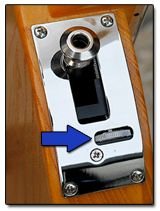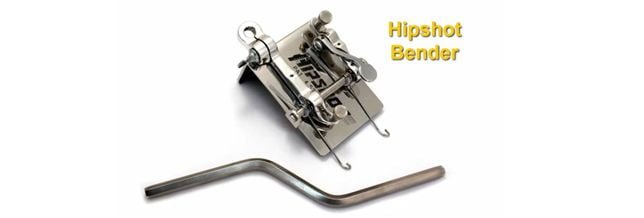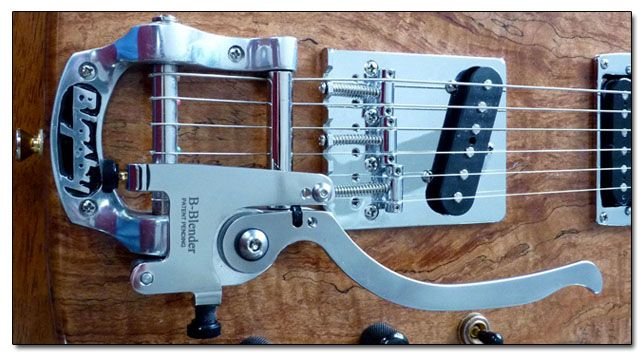This B-Bender system is activated by pulling down on the guitar, since the lever that moves the mechanism is attached to the strap.

This mechanism is responsible for raising the note of a string, a whole tone. Consequently, if we press a G on the third string, when activating the system, we would take the note to an A. But progressively as we activate the mechanism, as if we were doing a bending, but even easier. Since by operating the mechanism to its maximum travel, we will be sure that the note is perfectly in tune.
B-Bender Tunnig
We can adjust the intonation perfectly, by means of a control or tuner that adjusts the path of the device.

If we activate the system only halfway, we would obtain a bending of one semitone. But for that semitone to be well in tune, we will have to have good sense so that it does not sound out of tune.
This system offers us the possibility of bending a string, and at the same time having the option of plucking the rest of the strings. Since when executing a stretch, the fingers wind the upper or lower strings, depending on the trajectory of the bending, leaving those strings disabled at that moment.
The B-Bender would also allow us to bend within a chord, without the need to change the position of the hand, with the advantage of having at our disposal the rest of the notes that make up the chord.
B-Bender Types
In front of the name Bender, there is usually a letter indicating which string the mechanism acts on.

G-Bender
If the system drives the third string, it is called a G-Bender. And if you pull the second string, it’s called a B-Bender. G for the note of the third string, and B for the note of the second string.
If I played on both strings at the same time, it would be B/G-Bender. It is also generally known simply as the B-Bender. Since the B note of the second string in the open, is the note in which this system is usually applied in a general way.
Double Bender
A double independent system can also be installed, which activates two strings separately. One mechanism would be attached to the strap, and the other would be attached to the guitarist’s waist with a carabiner. For example on the belt, or on a trouser loop (image below left). In the image on the right we see the two independent tuners for each mechanism.

The sound obtained for the Bender is very characteristic of Country, Folk or Bluegrass music. But this system is adaptable to any musical genre. It is even used by Rock guitarists like Jimmy Page from Led zeppelin, the band The Eagles, or James Hetfield from Metallica in “Unforgiven II”.
In order to install the standard system of this mechanism, we will have to remove a large part of the wood of our guitar, with the possibility of losing some tone and sustain in the process. This type of b-bender can only be installed on guitars with a fixed bridge that can support such a recess, mainly Telecaster and Les Paul models.

Some guitars come with this system installed as standard, such as the Fender Nashville B-Bender Telecaster. This guitar has the typical pickups of a Telecaster, and also has a single Texas Special pickup in the center position, to increase its versatility.

Glaser Bender
To avoid such an invasive recess in our guitar when installing this system, other less drastic bender models were designed, such as the Glaser Bender. This system is basically the same as the standard one, but without having to trim the wood on the back of the guitar. The Glaser Bender incorporates its entire mechanism in the area of the pickup cavities, with the advantage of being able to be installed on guitars with a semi-floating bridge.

B-Bender System: Hipshot Bender
We also have other systems that are not so complicated to install, and without having to remove any wood from the guitar. As for example the Hipshot Bender system, and also this system can be used in different strings.


This device is operated by a lever placed on the guitarist’s hip and is activated by pulling the guitar toward the neck. However, it can also be operated by pressing a lever with the hand. This system is integrated into the G&L Will Ray model with three pickups of double coil to eliminate hum and with a ceramic magnet.

Bowden B-Bender System
There is also another less cumbersome system, very easy to install, and for most electric guitar models, and even for acoustic guitars: the Bowden B-Bender system.

The fastening of this bender is very simple, we would only have to fix it to the bridge or tailpiece of our guitar, and that’s it.
On acoustic guitars it would simply be removing a pivot from a string, inserting a threaded rod through the hole in the pivot, and placing a wing nut through the sound hole of the guitar. Then we put the string in the system, and ready to go.

B-Bender System: Rolling Bender
In the same style, but somewhat more discreet than the previous one, we have the Rolling Bender.

This can be operated by hand, or with a cable attached to the waist. But in the latter case, we would have to drill the guitar, to be able to pass the cable through the hole.

There is also a suitable B-Bender model to install on the Bigsby vibrato, although this type of accessory is not easy to find.

Parts of the Electric Guitar: Information
